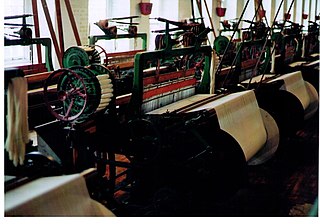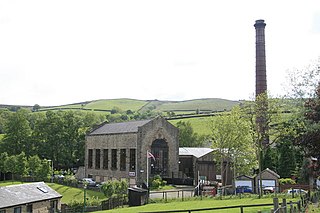
A loom is a device used to weave cloth and tapestry. The basic purpose of any loom is to hold the warp threads under tension to facilitate the interweaving of the weft threads. The precise shape of the loom and its mechanics may vary, but the basic function is the same.

Weaving is a method of textile production in which two distinct sets of yarns or threads are interlaced at right angles to form a fabric or cloth. Other methods are knitting, crocheting, felting, and braiding or plaiting. The longitudinal threads are called the warp and the lateral threads are the weft, woof, or filling. The method in which these threads are interwoven affects the characteristics of the cloth. Cloth is usually woven on a loom, a device that holds the warp threads in place while filling threads are woven through them. A fabric band that meets this definition of cloth can also be made using other methods, including tablet weaving, back strap loom, or other techniques that can be done without looms.

The spinning jenny is a multi-spindle spinning frame, and was one of the key developments in the industrialisation of textile manufacturing during the early Industrial Revolution. It was invented in 1764–1765 by James Hargreaves in Stan hill, Oswaldtwistle, Lancashire in England.

A power loom is a mechanized loom, and was one of the key developments in the industrialization of weaving during the early Industrial Revolution. The first power loom was designed and patented in 1785 by Edmund Cartwright. It was refined over the next 47 years until a design by the Howard and Bullough company made the operation completely automatic. This device was designed in 1834 by James Bullough and William Kenworthy, and was named the Lancashire loom.

In the manufacture of cloth, warp and weft are the two basic components in weaving to transform thread and yarn into textile fabrics. The vertical warp yarns are held stationary in tension on a loom (frame) while the horizontal weft is drawn through the warp thread. In the terminology of weaving, each warp thread is called a warp end ; a pick is a single weft thread that crosses the warp thread.

Textile manufacture during the British Industrial Revolution was centred in south Lancashire and the towns on both sides of the Pennines in the United Kingdom. The main drivers of the Industrial Revolution were textile manufacturing, iron founding, steam power, oil drilling, the discovery of electricity and its many industrial applications, the telegraph and many others. Railroads, steamboats, the telegraph and other innovations massively increased worker productivity and raised standards of living by greatly reducing time spent during travel, transportation and communications.

Textile manufacturing or textile engineering is a major industry. It is largely based on the conversion of fibre into yarn, then yarn into fabric. These are then dyed or printed, fabricated into cloth which is then converted into useful goods such as clothing, household items, upholstery and various industrial products.

In weaving, the shed is the temporary separation between upper and lower warp yarns through which the weft is woven. The shed is created to make it easy to interlace the weft into the warp and thus create woven fabric. Most types of looms have some sort of device which separates some of the warp threads from the others. This separation is called the shed, and allows for a shuttle carrying the weft thread to move through the shed perpendicular to the warp threads. Which threads are raised and which are lowered are changed after each pass of the shuttle.

Howard & Bullough was a firm of textile machine manufacturers in Accrington, Lancashire. The company was the world's major manufacturer of power looms in the 1860s.

A weavers' cottage was a type of house used by weavers for cloth production in the putting-out system sometimes known as the domestic system.

The Northrop Loom was a fully automatic power loom marketed by George Draper and Sons, Hopedale, Massachusetts beginning in 1895. It was named after James Henry Northrop who invented the shuttle-charging mechanism.

The Roberts loom was a cast-iron power loom introduced by Richard Roberts in 1830. It was the first loom that was more viable than a hand loom and was easily adjustable and reliable, which led to its widespread use in the Lancashire cotton industry.

A reed is part of a weaving loom, and resembles a comb or a frame with many vertical slits. It is used to separate and space the warp threads, to guide the shuttle's motion across the loom, and to push the weft threads into place. In most floor looms with, the reed is securely held by the beater. Floor looms and mechanized looms both use a beater with a reed, whereas Inkle weaving and tablet weaving do not use reeds.

Queen Street Mill is a former weaving mill in Harle Syke, a suburb to the north-east of Burnley, Lancashire, that is a Grade I listed building. It now operates as a museum and cafe. Currently open for public tours between April and November. Over winter the café is opened on Wednesdays. It is also viewable with private bookings.

A weaving shed is a distinctive type of mill developed in the early 1800s in Lancashire, Derbyshire and Yorkshire to accommodate the new power looms weaving cotton, silk, woollen and worsted. A weaving shed can be a stand-alone mill, or a component of a combined mill. Power looms cause severe vibrations requiring them to be located on a solid ground floor. In the case of cotton, the weaving shed needs to remain moist. Maximum daylight is achieved, by the sawtooth "north-facing roof lights".

The technique of sizing a warp was mechanised during the nineteenth century when William Radcliffe and his assistant Thomas Johnson invented the sizing machine. The purpose of introducing size, which is either a starchy substance for cotton or gelatinous mixture for woollen fibre, is to reduce the chances of threads fraying and breaking due to the friction of the weaving process. The size stiffens the thread and helps the fibres lie closely together. Many recipes for size can be found in textile manufacturing books. The recipes include flour, sago, china clay, types of soap, fats and some chemicals.

Bancroft Shed was a weaving shed in Barnoldswick, Lancashire, England, situated on the road to Skipton. Construction was started in 1914 and the shed was commissioned in 1920 for James Nutter & Sons Limited. The mill closed on 22 December 1978 and was demolished. The engine house, chimneys and boilers have been preserved and maintained as a working steam museum. The mill was the last steam-driven weaving shed to be constructed and the last to close.

The more looms system was a productivity strategy introduced in the Lancashire cotton industry, whereby each weaver would manage a greater number of looms. It was an alternative to investing in the more productive Northrop automatic looms in the 1930s. It caused resentment, resulted in industrial action, and failed to achieve any significant cost savings.

"Kissing the shuttle" is the term for a process by which weavers used their mouths to pull thread through the eye of a shuttle when the pirn was replaced. The same shuttles were used by many weavers, and the practice was unpopular. It was outlawed in the U.S. state of Massachusetts in 1911 but continued even after it had been outlawed in Lancashire, England in 1952. The Lancashire cotton industry was loath to invest in hand-threaded shuttles, or in the more productive Northrop automatic looms with self-threading shuttles, which were introduced in 1902.
William Horrocks, a cotton manufacturer of Stockport built an early power loom in 1803, based on the principles of Cartwright but including some significant improvements to cloth take up and in 1813 battening.




















